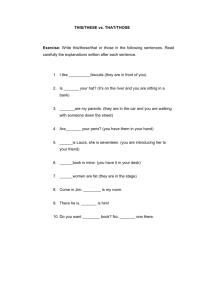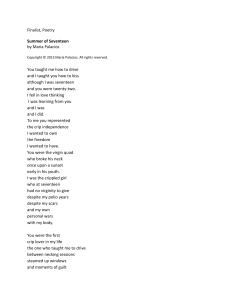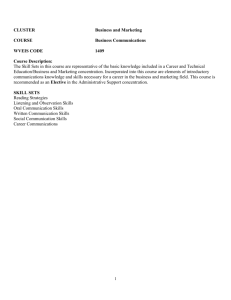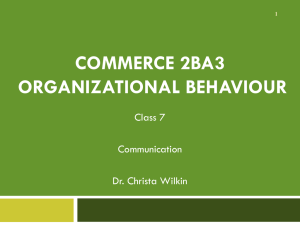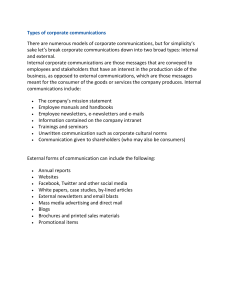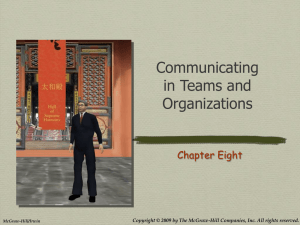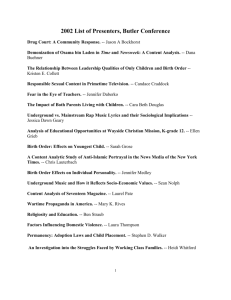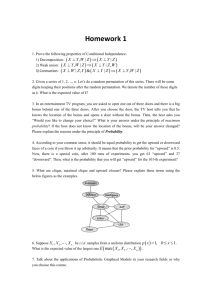Chapter 18 - UPM EduTrain Interactive Learning
advertisement
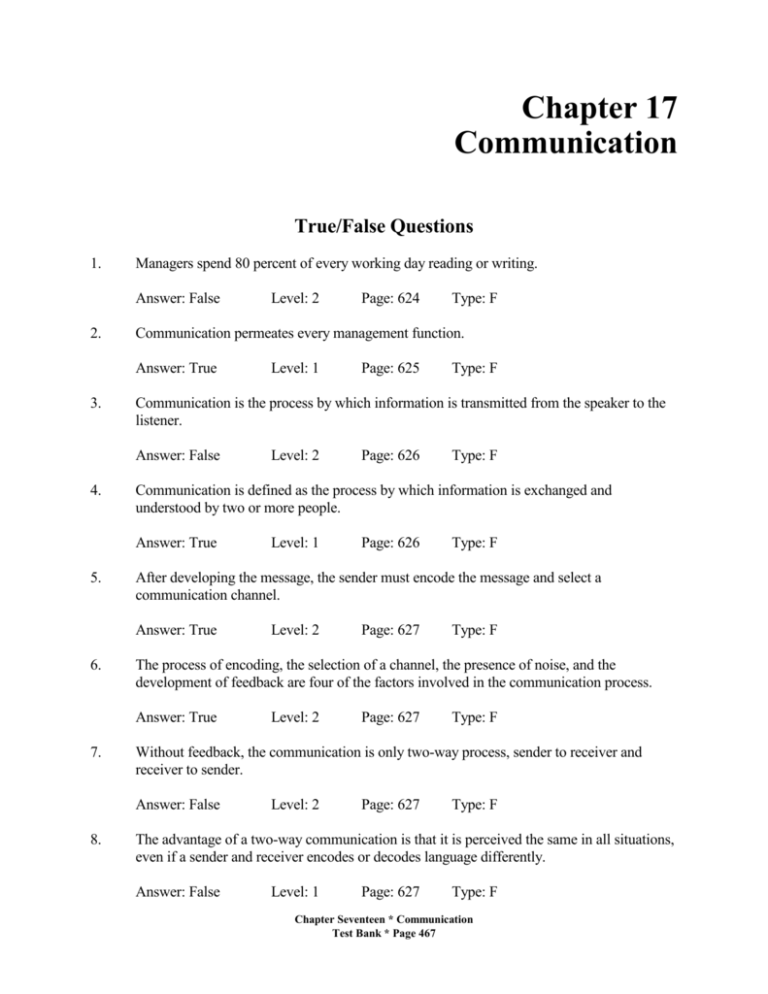
Chapter 17 Communication True/False Questions 1. Managers spend 80 percent of every working day reading or writing. Answer: False 2. Level: 2 Page: 626 Type: F Level: 1 Page: 626 Type: F Level: 2 Page: 627 Type: F Level: 2 Page: 627 Type: F Without feedback, the communication is only two-way process, sender to receiver and receiver to sender. Answer: False 8. Type: F The process of encoding, the selection of a channel, the presence of noise, and the development of feedback are four of the factors involved in the communication process. Answer: True 7. Page: 625 After developing the message, the sender must encode the message and select a communication channel. Answer: True 6. Level: 1 Communication is defined as the process by which information is exchanged and understood by two or more people. Answer: True 5. Type: F Communication is the process by which information is transmitted from the speaker to the listener. Answer: False 4. Page: 624 Communication permeates every management function. Answer: True 3. Level: 2 Level: 2 Page: 627 Type: F The advantage of a two-way communication is that it is perceived the same in all situations, even if a sender and receiver encodes or decodes language differently. Answer: False Level: 1 Page: 627 Type: F Chapter Seventeen * Communication Test Bank * Page 467 9. The number of cues and the level of potential noise in a channel that is selected for communication refer to the channel richness. Answer: False 10. Type: F Level: 2 Page: 629 Type: F Level: 1 Page: 631 Type: F Level: 3 Page: 631 Type: F Level: 1 Page: 631 Type: F Level: 2 Page: 632 Type: F Forms of nonverbal communication include blushing, perspiring, glancing, crying, and laughing. Answer: True 18. Page: 629 Presenting hard facts and figures has the same power as telling vivid stories. Answer: False 17. Level: 2 The choice of a communication channel can convey a symbolic meaning to the receiver. Answer: True 16. Type: F To persuade and influence, managers connect with others primarily by using impersonal written media such as fliers and bulletins. Answer: False 15. Page: 629 Routine messages typically are ambiguous, concern novel events and impose great potential for misunderstanding. Answer: False 14. Level: 1 Only by selecting rich channels can managers communicate nonroutine messages effectively. Answer: True 13. Type: F Impersonal written media, including fliers and bulletins, are the lowest in channel richness. Answer: True 12. Page: 628 In terms of channel richness, face-to-face discussion is the richest channel. Answer: True 11. Level: 2 Level: 1 Page: 632 Type: F When verbal and nonverbal messages are contradictory, the receiver usually will give more weight to behavioral actions than to verbal messages. Answer: True Level: 2 Page: 632 Type: F Chapter Seventeen * Communication Test Bank * Page 468 19. Formulating in your mind what you are going to say next is an important part of effective listening. Answer: False 20. Type: F Level: 1 Page: 636 Type: F Level: 2 Page: 636 Type: F Level: 2 Page: 637 Type: F Level: 2 Page: 637 Type: F Level: 2 Page: 637 Type: F The lateral or diagonal exchange of messages among peers or coworkers is horizontal communication. Answer: True 28. Page: 635 Types of information generally communicated upwards include performance reports, suggestions for improvement and performance feedback. Answer: False 27. Level: 2 Performance reports and suggestions for improvement are two types of upward communication. Answer: True 26. Type: F Performance feedback is an example of upward communication. Answer: False 25. Page: 635 The major problem with downward communication is drop off, the distortion or loss of message content. Answer: True 24. Level: 1 The topics covered in upward communication are indoctrination and implementation of goals and strategies. Answer: False 23. Type: F Downward communication is the most familiar and obvious flow of informal communication. Answer: False 22. Page: 633 A formal communication channel is a communication channel that flows within the chain of command. Answer: True 21. Level: 1 Level: 1 Page: 638 Type: F Interdepartmental coordination are messages that take place among members of the same Chapter Seventeen * Communication Test Bank * Page 469 department and concern task accomplishment. Answer: False 29. Type: F Level: 1 Page: 640 Type: F Level: 1 Page: 641 Type: F Level: 1 Page: 641 Type: F Level: 2 Page: 642 Type: F Level: 2 Page: 644 Type: F In the new workplace, learning occurs when managers use evaluation and communication to help individuals and the organization learn and improve. Answer: False 37. Page: 639 A discussion is often resolved by logic or "beating down" opponents, whereas, dialogue asks that participants suspend their attachments to a particular viewpoint so that a deeper level of listening, synthesis, and meaning can evolve from the group. Answer: True 36. Level: 2 A few individuals each convey information to several others in a gossip chain. Answer: False 35. Type: F Two types of informal channels used in many organizations are MBWA and grapevine. Answer: True 34. Page: 639 Informal communication channels exist within the formally authorized channels and adhere to the organization's hierarchy of authority. Answer: False 33. Level: 2 In centralized networks, team members must communicate through one individual to solve problems or make decisions. Answer: True 32. Type: F Horizontal communication is particularly important in teaching organizations, where teams of workers are continuously solving problems and searching for new ways of doing things. Answer: False 31. Page: 639 Messages that are designed to share information among teams and departments that can help the organization change, grow, or improve are called change initiatives and improvements. Answer: True 30. Level: 2 Level: 2 Page: 645 Type: F Types of individual barriers to communication are interpersonal dynamics, semantics, and inconsistent cues. Chapter Seventeen * Communication Test Bank * Page 470 Answer: True 38. Page: 647 Type: F Selecting the wrong medium for sending a communication would not be a problem if the message has value. Answer: False 39. Level: 1 Level: 1 Page: 647 Type: F The most important thing managers can do for the organization is to teach listening in passive mode. Answer: False Level: 2 Page: 649 Type: F Multiple Choice Questions 1. A manager might use ______ as a type of communication. a. b. c. d. e. meetings telephone conversations talking informally all of the above a and b only Answer: d 2. Page: 624 Type: F What percentage of a manager's time is spent in direct communication? a. b. c. d. e. 20 percent 100 percent 50 percent 80 percent 40 percent Answer: d 3. Level: 2 Level: 2 Page: 624 Type: F What kinds of skills are fundamental necessities in every part of a manager's job? a. b. c. d. e. Organizational Communication MBWA Analysis Punishment Answer: b Level: 2 Page: 626 Type: F Chapter Seventeen * Communication Test Bank * Page 471 4. Communication is defined by the text as the process by which information is a. b. c. d. e. shared. exchanged and understood by two or more people, usually with the intent to motivate or influence behavior. received. transmitted to others. stored. Answer: b 5. Level: 2 Page: 627 Type: F Which of these is necessary for communication to be considered two-way? a. b. c. d. e. Message Channel Feedback Noise Circuit Answer: c The receiver a. b. c. d. e. Level: 2 Page: 627 Type: F the symbols to interpret the meaning of the message. encodes transmits decodes responds to must ignore Answer: c 8. Type: F Encoding, message, and feedback Encoding, noise, and symbols Message, circuit, and decoding Feedback, message, and perception Feedback, circuit, and perception Answer: a 7. Page: 626 What are the key elements of communication? a. b. c. d. e. 6. Level: 2 Level: 2 Page: 627 Type: F The job of the _______, in the communication process, is to decode the symbols and interpret the meaning of the message. a. sender Chapter Seventeen * Communication Test Bank * Page 472 b. c. d. e. receiver channel filter middleman Answer: b 9. Level: 2 Page: 627 Type: F When an electronic mail system is installed as part of the communication system, what element of the communication process is changed? a. b. c. d. e. Channel Message Sender Filter Receiver Answer: a Level: 2 Page: 628 Type: F Which of these refers to the amount of information that can be transmitted during a communication episode? a. b. c. d. e. Channel richness Electronic mail Encoding Upward communication Feedback Answer: a 12. Type: F Encoding, channel Encoding, noise Decoding, channel Decoding, encoding Decoding, noise Answer: d 11. Page: 627 and are potential sources for communication errors, because knowledge, attitudes, and background act as filters. a. b. c. d. e. 10. Level: 2 Level: 1 Page: 628 Type: F Channel richness refers to the a. b. c. d. number of messages a channel can carry at one time. speed in which messages can be carried. amount of information that can be transmitted during a communication episode. number of channels available at any one time. Chapter Seventeen * Communication Test Bank * Page 473 e. profitability potential of a proposed channel. Answer: c 13. Level: 1 Page: 629 Type: F The capacity of an information channel is influenced by all of these except a. b. c. d. e. the ability to establish a personal focus. the ability to handle multiple cues simultaneously. the ability to facilitate rapid, two-way feedback. the ability to minimize costs. a and c. Answer: d Level: 1 Page: 629 Type: F ______ is the richest medium for communication. a. b. c. d. e. Telephone conversations Face to face contact Electronic media Written media Voice mail Answer: b 16. Type: F Newsletter, telephone, and feedback Telephone, electronic mail, and memo Television, encoding, and letter National newspapers and television All of the above Answer: b 15. Page: 628 ______ are examples of channels which managers might choose to use when communicating with employees. a. b. c. d. e. 14. Level: 1 Level: 1 Page: 629 Type: F Which of these mediums for communication does not focus on a single receiver, uses limited information cues, and does not permit feedback? a. b. c. d. e. Bulletins Telephone conversations Video conference Face to face contact A personal memo Answer: a Level: 1 Page: 629 Type: F Chapter Seventeen * Communication Test Bank * Page 474 17. ______ comprises the lowest channel richness. a. b. c. d. e. Electronic mail Bulletins Face-to-face talk Telephone Memos Answer: b 18. Level: 2 Page: 629 Type: F A disadvantage of low channel richness is a. b. c. d. e. no record. spontaneous. two-way. slow feedback. premeditated. Answer: d Level: 2 Page: 629 Type: F Which of these is an advantage of high channel richness? a. b. c. d. e. Slow feedback Premeditated Provides record Easily disseminated Personal Answer: e 21. Type: F Impersonal Two-way Premeditated Fast-feedback No records to worry about Answer: c 20. Page: 629 _______ is an advantage of low channel richness. a. b. c. d. e. 19. Level: 2 Level: 2 Page: 629 Type: F Which of these is a disadvantage of high channel richness? a. b. c. d. Spontaneous One-way Slow feedback Premeditated Chapter Seventeen * Communication Test Bank * Page 475 e. Impersonal Answer: a 22. Level: 2 Page: 630 Type: F Which of these is typically ambiguous, concern novel events, and impose great potential for misunderstanding? a. b. c. d. e. Nonroutine messages Channel richness Routine messages Feedback Nonverbal communications Answer: a Level: 1 Page: 631 Type: F To inform managers of impending company-wide layoff, which communication channel would be most successful? a. b. c. d. e. Telephone conversations Face to face contact Electronic media Written media None of the above Answer: b 25. Type: F posture. facial expression. voice. written memo. a and b only. Answer: d 24. Page: 629 An example of non-verbal communication is all of these except a. b. c. d. e. 23. Level: 2 Level: 2 Page: 631 Type: A When informing your staff of the date for the company picnic, which communication channel would be most practical and successful? a. b. c. d. e. Memo Telephone Video conference Face to face contact A newspaper notice Answer: a Level: 2 Page: 631 Type: A Chapter Seventeen * Communication Test Bank * Page 476 26. To persuade and influence, managers connect with others by using a. b. c. d. e. a policy manual. symbols, metaphors, and stories. statistical facts and figures. rules and regulations. external consultants. Answer: b 27. Level: 2 Page: 632 Type: F A communication transmitted through actions and behaviors rather than through words is known as a. b. c. d. e. verbal communication. oral communication. written communication. nonverbal communication. electronic mail. Answer: d Level: 1 Page: 632 Type: F You invite one of your employees to your office to talk about his performance. Which of the following seating arrangements will suggest to him that you are the person in charge? a. b. c. d. e. You sit in an easy chair and your employee sits on the sofa. You sit behind your desk and your employee sits in a chair on the opposite side. You both sit side by side around a table. You sit in a sofa and your employee sits in an easy chair. You both sit on the floor. Answer: b 30. Type: F video conference telephone formal letter face to face communication newspaper article Answer: d 29. Page: 632 Non-verbal communication has the biggest impact when using _______. a. b. c. d. e. 28. Level: 2 Level: 2 Page: 633 Type: A Most executives now believe that important information flows from the Chapter Seventeen * Communication Test Bank * Page 477 a. b. c. d. e. top down. bottom up. diagonal level. horizontal level to diagonal level. internal to external. Answer: b 31. Level: 1 Page: 633 Type: F Keys to effective listening include all of the following EXCEPT a. b. c. d. e. find areas of interest. listen for ideas. be responsive. have preconceptions. all of the above are keys to effective listening. Answer: d Level: 2 Page: 634 Type: F Which of the following is(are) part of keys to effective listening? a. b. c. d. e. Listen for facts Listen for ideas Be passive, laid back Have preconceptions All of the above Answer: b 34. Type: F communication listening managing reception telling Answer: b 33. Page: 633 The skills of require receiving messages to accurately grasp facts and feelings to interpret the meaning of the message. a. b. c. d. e. 32. Level: 2 Level: 3 Page: 634 Type: F Characteristics of a good listener are someone who a. b. c. d. e. asks questions, listens for facts, and avoids distractions. asks questions, summarizes, and listens to central themes. shows interest, judges content, and has preconceptions. listens between lines, starts to argue, and works hard. shows interest, works hard, and starts to argue. Chapter Seventeen * Communication Test Bank * Page 478 Answer: b 35. Page: 634 Type: F Formal communication Horizontal communication Downward communication Upward communication Diagonal communication Answer: a Level: 2 Page: 635 Type: F The learning organizations emphasize which of these? a. b. c. d. e. Downward communication Gossips Horizontal communication Upward communication Vertical communication Answer: c Level: 1 Page: 635 Type: F _______ is the most familiar and obvious flow of formal communication. a. b. c. d. e. Downward communication Gossips Horizontal communication Upward communication Vertical communication Answer: a 39. Level: 2 ______ is described by the text as a communication channel that flows within the chain of command or task responsibility defined by the organization. a. b. c. d. e. 38. Type: F asking questions. having preconceptions. tolerates bad habits. judges content, not delivery errors. all of the above. Answer: b 37. Page: 634 Good listeners exhibit all of the following characteristics EXCEPT a. b. c. d. e. 36. Level: 2 Level: 1 Page: 635 Type: F Downward communication is usually used to communicate information about all of the following EXCEPT Chapter Seventeen * Communication Test Bank * Page 479 a. b. c. d. e. indoctrination. procedures. performance feedback. suggestions for improvement. implementation of goals. Answer: d 40. Level: 2 Page: 636 Type: F Messages that appraise how well individuals and departments are doing their jobs are called a. b. c. d. e. job instructions. implementation of strategies. practices. performance feedback. indoctrination. Answer: d Level: 2 Page: 636 Type: F Messages designed to motivate employees to adopt the company’s mission and cultural values and to participate in special ceremonies are called a. b. c. d. e. job instructions. implementation of strategies. practices. performance feedback. indoctrination. Answer: e 43. Type: F upward communication. formal communication. downward communication. informal communication. horizontal communication. Answer: c 42. Page: 636 Information distortion or loss of message content is a major problem with a. b. c. d. e. 41. Level: 2 Level: 2 Page: 636 Type: F Many organizations use suggestion boxes, open door policies, and surveys to facilitate a. b. c. d. upward communication. downward communication. formal communication. informal communication. Chapter Seventeen * Communication Test Bank * Page 480 e. diagonal communication. Answer: a 44. Level: 2 Page: 637 Type: F When a group of workers have routine tasks to perform, a allows more time for the task to be completed. a. b. c. d. e. communication structure linear centralized decentralized gossip team Answer: b Level: 1 Page: 637 Type: A Casey is a part of a software engineering team. Her task is to develop a diagnostic program for the medical profession. This is a very complex task. What type of communication structure would work best for her group? a. b. c. d. e. Linear Centralized Decentralized Focused All of the above Answer: c 47. Type: F suggestions for improvement. performance reports. indoctrination. financial and accounting information. grievance and disputes. Answer: c 46. Page: 637 Upward communication is usually used to communicate information about all of the following EXCEPT a. b. c. d. e. 45. Level: 2 Level: 1 Page: 637 Type: A is used for solving intradepartmental problems, interdepartmental coordination, and change initiatives and improvements. a. b. c. d. e. Downward communication Horizontal communication Upward communication Vertical communication Informal communication Chapter Seventeen * Communication Test Bank * Page 481 Answer: b 48. Level: 2 Page: 640 Type: F A centralized network is one in which a. b. c. d. e. team members are free to interact with any of the team members. team members communicate through one individual to make decisions. team members communicate with an assigned partner. team members work independently and there is no need for communication. none of the above. Answer: b Level: 2 For complex problems, a resolution. a. b. c. d. e. Page: 640 Type: F network is most effective for swift, accurate problem linear centralized decentralized all of the above a and b only Answer: c 51. Type: F Decentralized network Centralized network Linear network Circular network Gossip structure Answer: a 50. Page: 638 Which of these refers to a team communication structure in which team members freely communicate with one another and arrive at decisions? a. b. c. d. e. 49. Level: 2 Level: 2 Page: 640 Type: F What communication channels that exist outside the formally authorized channels without regard for the organization's hierarchy of authority? a. b. c. d. e. Management by wandering around The grapevine Informal communication Horizontal communication Upward communication Answer: c Level: 2 Page: 641 Type: F Chapter Seventeen * Communication Test Bank * Page 482 52. As a manager, Claire decides that every afternoon, you are going to spend time with her employees to find out what's happening. This is called a. b. c. d. e. the grapevine. management by wandering around. horizontal communication. downward communication. diagonal communication. Answer: b 53. Level: 2 Page: 642 Type: F The grapevine is an important means of communication that exists in companies. Most of the information passed through the grapevine is a. b. c. d. e. personal information. vicious gossip. business-related. destructive because it is not accurate. none of the above. Answer: c Level: 2 Page: 642 Type: F What percent of the details passed through a grapevine is accurate? a. b. c. d. e. 15 to 20 percent 25 to 35 percent 40 to 60 percent 70 to 90 percent 100 percent Answer: d 56. Type: A Management by wandering around Vertical communication Diagonal communication The grapevine Upward communication Answer: d 55. Page: 641 ______ links employees in all directions, ranging from the president through middle management, support staff, and line employees. a. b. c. d. e. 54. Level: 2 Level: 3 Page: 643 Type: F A group communication process aimed at creating a culture based on collaboration, fluidity, trust, and commitment to shared goals is referred to as a(n) Chapter Seventeen * Communication Test Bank * Page 483 a. b. c. d. e. MBWA. dialogue. open communication. centralized system. gossip. Answer: b 57. Level: 2 Page: 645 Type: F ______ is an important means by which individuals and organizations learn from their mistakes and improve their work. a. b. c. d. e. Feedback Learning Teaching Channeling Barrier Answer: a Level: 1 Page: 645 Type: F _______ communication can exist within the individual or as part of the organization. a. b. c. d. e. Channels of Cues of Barriers to Semantics of Feedback from Answer: c 60. Type: F feedback learning teaching channeling barrier Answer: a 59. Page: 644 When managers use evaluation and communication to help individuals and the organization learn and improve, ______ occurs. a. b. c. d. e. 58. Level: 1 Level: 2 Page: 647 Type: F Which of the following is an individual barrier to communication? a. b. c. d. Status and power difference Lack of formal channels Communication network unsuited to task Semantics Chapter Seventeen * Communication Test Bank * Page 484 e. All of the above Answer: d 61. Writing works best for a. b. c. d. e. the capacity for rapid feedback. Level: 3 Page: 647 Type: F Semantic barrier Interpersonal barrier Wrong channel selection Inconsistent cues between verbal and nonverbal communication Lack of formal channels Answer: b Level: 2 Page: 647 Type: A All of these are all examples of individual barriers to communication EXCEPT a. b. c. d. e. semantics. wrong channel selection. status of power differences. interpersonal barriers. inconsistent cues. Answer: c 64. messages but Type: F Monica knows that her supervisor does not like her. When her supervisor talks to her about increasing effectiveness, Monica knows he is just hassling her instead of soliciting her ideas. This is an example of what type of barrier to communication? a. b. c. d. e. 63. Page: 647 routine, lacks routine, provides nonroutine, lacks nonroutine, provides none of the above Answer: a 62. Level: 2 Level: 2 Page: 647 Type: F Planners Consulting Group uses its electronic mail system to inform employees of many upcoming events. Unfortunately, many employees do not have access to or don't use computers on a regular basis. This is an example of what type of communication barrier? a. b. c. d. e. Semantics Wrong channel selection Status or power differences Interpersonal barriers Inconsistent cues Chapter Seventeen * Communication Test Bank * Page 485 Answer: b 65. Page: 647 Type: F Status and power differences Wrong channel selection Improper communication flow Absence of formal channels All of the above are examples of organizational barriers to communication Answer: b Level: 2 Page: 647-648 Type: F ______ is an organizational barrier to communication. a. b. c. d. e. Semantics Interpersonal dynamics Status and power difference Inconsistent cues All of the above Answer: c Level: 2 Page: 647 Type: F Perhaps the most important individual skill in overcoming communication barriers is a. b. c. d. e. selecting appropriate channel for the message. MBWA. active listening. developing and using formal information channels. finding a fit between the structure and the communication needs. Answer: c 69. Level: 2 Which of the following is NOT an example of an organizational barrier to communication? a. b. c. d. e. 68. Type: A Semantics Wrong channel selection Status or power differences Interpersonal barriers Inconsistent cues Answer: a 67. Page: 647 The word "effectiveness" may mean one thing to one person and something different to another person. This is an example of what kind of a barrier? a. b. c. d. e. 66. Level: 2 Level: 2 Page: 648 Type: F According to the text, one of the most important things that a manager can do for the organization is to Chapter Seventeen * Communication Test Bank * Page 486 a. b. c. d. e. talk to their employees. create a climate of trust and openness. listen to their employees. ensure that production remains high. none of the above. Answer: b 70. Level: 2 Page: 648 Type: F To ensure positive, effective communication, managers should use which of the following techniques? a. b. c. d. e. Multiple channels of communication Management by wandering around Formal communication channels All of the above a and c only Answer: d Level: 2 Page: 648-649 Type: F Scenario Questions Scenario – Taryn Reynolds One of the most talented managers to ever work at Lime Mining is Taryn Reynolds. Combining graciousness with high intelligence and creativity, Taryn has been successful in attracting and building a highly committed and competent division of employees. When interviewed by the national news media for insight into her success, one of the topics that became a primary focus was the challenge of communicating effectively. 1. In selecting the best channel for complex communication, Taryn suggests to select the richest channel possible. Characteristics that Taryn suggests a manager should recognize include all of these EXCEPT which one? a. b. c. d. e. The channel's ability to handle multiple cues simultaneously The ability to facilitate rapid two-way feedback The ability to establish a personal focus for the communication The ability to clarify and rapidly reduce communication stereotyping All of these are valid characteristics of channel richness. Answer: d Type: A Chapter Seventeen * Communication Test Bank * Page 487 2. Taryn also agrees with the research that suggests that "nonverbal messages convey thoughts and feelings with greater force than do our most carefully selected words." Nonverbal messages include all of the following EXCEPT which one? a. b. c. d. e. Facial expressions Posture and dress Voice and mannerisms Blushing and perspiring All of the above are included. Answer: e 3. Taryn recently contributed some ideas to current management articles and she asserts the conclusion that effective listening and engaged listening are key characteristics of successful communication. Which of the following is not a part of effective listening or engaged listening? a. b. c. d. e. Provide listening forums Take notes and promise feedback Ask dumb questions Break down barriers through casual get-togethers All of the above are included. Answer: e 4. Type: A Type: A Taryn believes that successful managers solicit and respond to upward communication. Information that can be expected with upward communication includes all of the following EXCEPT which one? a. b. c. d. e. Procedures and practices Suggestions for improvement Financial and accounting information Performance reports All of the above are included. Answer: a Type: A Short-Answer Questions 1. can be defined as the process by which information is exchanged and understood by two or more people, usually with the intent to motivate or influence behavior. Chapter Seventeen * Communication Test Bank * Page 488 Answer: Communication 2. Page: 626 To ______ a message is to select the symbols used to compose a message. Answer: encode 3. The Page: 627 is the tangible formulation of the idea that is sent to the receiver. Answer: message 4. Page: 627 To translate the symbols used in a message for the purpose of interpreting its meaning is called . Answer: decoding 5. Without Page: 627 , the communication is one-way. Answer: feedback 6. Page: 627 The amount of information that can be transmitted during a communication episode is known as _______. Answer: channel richness 7. Page: 628 _______ is increasingly being used for messages that were once handled via the telephone. Answer: E-mail 8. Page: 629 ________ messages are typically ambiguous, concern novel events, and impose great potential for misunderstanding. Answer: Nonroutine 9. Page: 631 refers to messages sent through human actions and behaviors rather than through words. Answer: Nonverbal communication 10. involves the skill of grasping both facts and feelings to interpret a message's genuine meaning. Answer: Listening 11. Page: 632 Page: 633 channels are those that flow within the chain of command or task responsibility defined by the organization. Chapter Seventeen * Communication Test Bank * Page 489 Answer: Formal communication 12. Page: 635 List the three formal communication channels found in organizations. Answer: The three channels are (1) the upward communication channel, (2) the downward communication channel, and (3) the horizontal communication channel. Page: 635 13. refers to the messages and information sent from top management down to subordinates. Answer: Downward communication 14. The major problem with downward communication is known as communication _______. Answer: drop off 15. Page: 636 Formal includes messages that flow from the lower to the higher levels in the organization's hierarchy. Answer: upward communication 16. Page: 635 Page: 637 List the five types of upward communication. Answer: The five types of information communicated upward are (1) problems and expectations, (2) suggestions for improvement, (3) performance reports, (4) grievances and disputes, and (5) financial and accounting information. Page: 637 17. communication is the lateral or diagonal exchange of messages among peers or coworkers. Answer: Horizontal 18. Page: 638 Messages that take place among members of the same department and concern task accomplishments are called _______. Answer: intradepartmental problem solving Page: 638 19. Interdepartmental messages that facilitate the accomplishment of joint projects or tasks Chapter Seventeen * Communication Test Bank * Page 490 are called ______. Answer: interdepartmental coordination 20. 21. Messages that are designed to share information among teams and departments that can help the organization change, grow, and improve are called ______. Answer: change initiatives and improvements Page: 639 A(n) _______ is a team communication structure in which team members communicate through a single individual to solve problems or make decisions. Answer: centralized network 22. In a(n) Page: 640 channels exist outside the formally authorized channels and do not adhere to the organization's hierarchy of authority. Answer: Informal communication 24. Page: 640 network, individuals can communicate freely with other team members. Answer: decentralized 23. Page: 639 Page: 641 A communication technique in which managers interact directly with workers to exchange information is known as _______. Answer: management by wandering around Page: 641 25. The is an informal, person-to-person communication network of employees that is not officially sanctioned by the organization. Answer: grapevine 26. Page: 642 means sharing all types of information throughout the company, across functional and hierarchical levels. Answer: Open communication 27. is a group communication process in which people together create a stream of shared meaning that enables them to understand each other and share a view of the world. Answer: Dialogue 28. Page: 643 Page: 644 _______ occurs when managers use evaluations and communication to help individuals and the organization learn and improve. Chapter Seventeen * Communication Test Bank * Page 491 Answer: Feedback 29. Page: 645 ________ can exist within the individual or as part of the organization. Answer: Barriers 30. Page: 647 pertains to the meaning of words and the way they are used. Answer: Semantics 31. Page: 647 List the four individual level barriers to communication. Answer: The four barriers are (1) interpersonal dynamics, (2) channels and media, (3) semantics, and (4) inconsistent cues. Page: 647 Essay Questions 1. Briefly describe the communication process. ANSWER: The communication process begins with the development of a message. The message is encoded into symbols that are then sent through a selected channel. The symbols are then received and decoded into a received message and then the response is sent as feedback and the communication process is completed. Level: 2 2. Page: 627 Describe the concept of channel richness, specify the richest channel, and explain why it is so rich. ANSWER: Channel richness is the amount of information that can be transmitted during a communication episode. This is influenced by the ability to handle multiple cues simultaneously, the ability to facilitate rapid, two-way communication, and the ability to establish a personal focus for the communication. Face-to-face communication is the richest channel because it permits direct experience, multiple information cues, immediate feedback, and personal focus. Level: 3 Page: 628-631 Chapter Seventeen * Communication Test Bank * Page 492 3. Define nonverbal communication and briefly discuss its importance to communicating in organizations. ANSWER: Nonverbal communication refers to messages sent through human actions and behaviors rather than words. Sources of nonverbal communication can include facial expressions, voice, mannerisms, posture, dress, and even office arrangements. These nonverbal sources can be more important than the actual words that are spoken. When verbal and nonverbal messages are contradictory, a receiver will usually give more weight to the nonverbals. Managers must be sensitive to nonverbal sources when communicating and learn to coordinate their verbal and nonverbal messages. Level: 2 4. Page: 632-633 What is downward communication and what are five topics generally included with downward communication? ANSWER: Downward communication is those messages sent from top management down to subordinates. It normally includes (1) implementation of goals, strategies, and objectives, (2) job instructions and rationale, (3) procedures and practices, (4) performance feedback, and (5) indoctrination. Level: 2 5. Page: 635-636 Describe the three categories of horizontal communication. ANSWER: Intradepartmental problem solving is messages that take place among members of the same department and concern task accomplishment. Interdepartmental coordination is messages that facilitate the accomplishment of joint projects or tasks. Change initiatives and improvements are messages designed to share information among teams and departments that can help the organization change, grow, and improve. Level: 2 6. Page: 638-639 Describe the difference between centralized networks and decentralized networks. ANSWER: Centralized network is a team communication structure in which team members communicate through a single individual to solve problems or make decisions. In a decentralized network, the communication structure allows team members to Chapter Seventeen * Communication Test Bank * Page 493 communicate freely with one another and arrive at decisions together. Level: 2 7. Page: 640 Identify the four individual level barriers to communication and the ways to overcome them. ANSWER: The four individual level barriers are (1) interpersonal dynamics, (2) channels and media, (3) semantics, and (4) inconsistent cues. According to the text, the most important individual skill needed to help overcome barriers to communication is active listening. This means showing interest, asking questions, paraphrasing, and providing feedback to the sender. Next, individuals should select the appropriate channel for the message. The complexity of the message, among other factors, should be considered when determining the channel. Third, both parties need to make a special effort to understand each other's perspective so that semantics can be clarified. Last, management by wandering around gets the manager out of the office, allowing for face-to-face communication and direct observation. Level: 3 Page: 647 Chapter Seventeen * Communication Test Bank * Page 494

